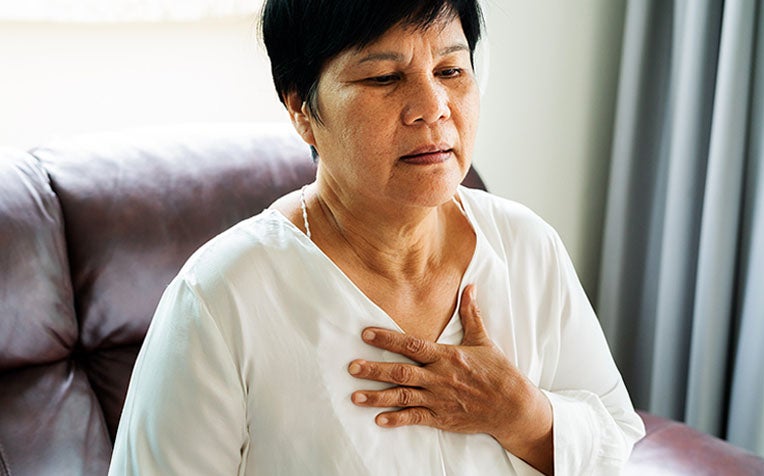
Women may experience heart attacks differently from men. Unlike the usual chest pain, symptoms can take the form of shortness of breath, cold sweat and pain in the arms, back neck, jaw or stomach.
Article contributed by the Department of Cardiology from National Heart Centre Singapore (NHCS), a member of the SingHealth group.
Heart attack symptoms for women
For both men and women, the most common symptom of a heart attack (myocardial infarction) is chest pain or discomfort, described as an achy, tight or “heavy” feeling.
However, a study featured in the Journal of the American Medical Association, found that women are more likely than men to have heart attacks that present without chest pains, and they are more likely to die of a heart attack than men.
Women are more likely than men to experience other signs of a heart attack such as:
Shortness of breath
Nausea
Feeling faint
Breaking out in a cold sweat
Pain in the arms, back, neck, jaw or stomach.
Women may also experience less common signs of a heart attack including:
Heartburn
Feeling tired
A cough
“Heart flutters”
Women may sometimes discount these clues as they don’t “feel” like a heart attack. It is important that these warning signs are not ignored and that a doctor be consulted immediately.
What to do during a heart attack
Call 995 for an ambulance.
Give clear instructions to paramedics on the location of the heart attack patient’s home, have someone wait at a visible location to guide the paramedics and hold the lift open if she lives in a high-rise building, so as to save time.
Chew and swallow an aspirin (if the patient is not allergic to it)
Get ready the patient’s personal records such as personal identification, medical benefit identification, insurance and other documents for admission.
Seat the heart attack patient in a location where she can be transferred easily to a stretcher.
Provide paramedics with a clear account of what happened.
Inform paramedics about the patient's drug allergies or past medical history
How is a heart attack treated? Watch this video to find out.
Causes of heart disease in women
When it comes to cardiovascular disease, women have some inherent risk factors. These include:
Age: Risk increases with age, especially after menopause.
Family: The risk is higher if a direct family member develops heart disease before 55 years for male relatives, or 65 years for female relatives.
Gender: Women usually experience heart attacks a decade or so later in life than men, and are more likely to die from them.
Ethnicity: In Singapore, ethnic differences in heart disease exist, with higher heart attack rates among Indians and a higher risk of dying from a heart attack among Malays.
Other risk factors, which are the same for males and females, can be managed with lifestyle modifications and medications. They include:
Smoking – Smoking increases the risk of a heart attack by two to three times; it causes more plaque to form and become unstable.
High cholesterol – High levels of LDL (“bad”) cholesterol or low levels of HDL (“good”) cholesterol increase the risk of coronary disease.
Hypertension (high blood pressure)
Obesity – Being overweight increases the levels of LDL cholesterol.
How is heart disease diagnosed and treated in women
Women should go for regular screenings to check for potential risk factors such as diabetes, abnormal cholesterol levels or high blood pressure.
Tests such as an electrocardiogram; cardiac stress test which can include an ultrasound or nuclear imaging test; computed tomography scan (CT scan), and a coronary angiogram may be carried out to detect heart disease.
Patients who are diagnosed with heart disease will be advised to take medication to relieve their symptoms and to reduce their risk of future heart attacks.
Those with more severe disease may have to undergo treatment to “unblock” their arteries either by placing metal stents (“spring-like” devices that act as “scaffolding”) in their coronary arteries, or they may have to undergo coronary artery bypass grafting surgery (CABG).
6 Ways to prevent heart disease
Heart disease is preventable, and women should take action to reduce their risk of heart disease by:
Exercising regularly
Not smoking
Eating healthily and maintaining a healthy weight
Getting their blood pressure and cholesterol levels checked regularly
Keeping chronic conditions such as diabetes in check
Following doctor’s advice and diligently taking prescribed medication
These protective lifestyle factors have been shown to markedly decrease the risk of cardiovascular disease for women in Singapore. Women who already suffer from cardiovascular disease can lower their risk of having a heart attack by up to 80 per cent by leading a healthy lifestyle.
Ladies, want to know more about heart disease risk and prevention, watch this video!
Ref: T12
Check out other articles on heart health:
How to Survive a Heart Attack When Alone
Sudden Chest Pains You Shouldn't Ignore
Heart Palpitations: When Are They Serious?
How a Viral Infection Can Affect the Heart



















 Get it on Google Play
Get it on Google Play